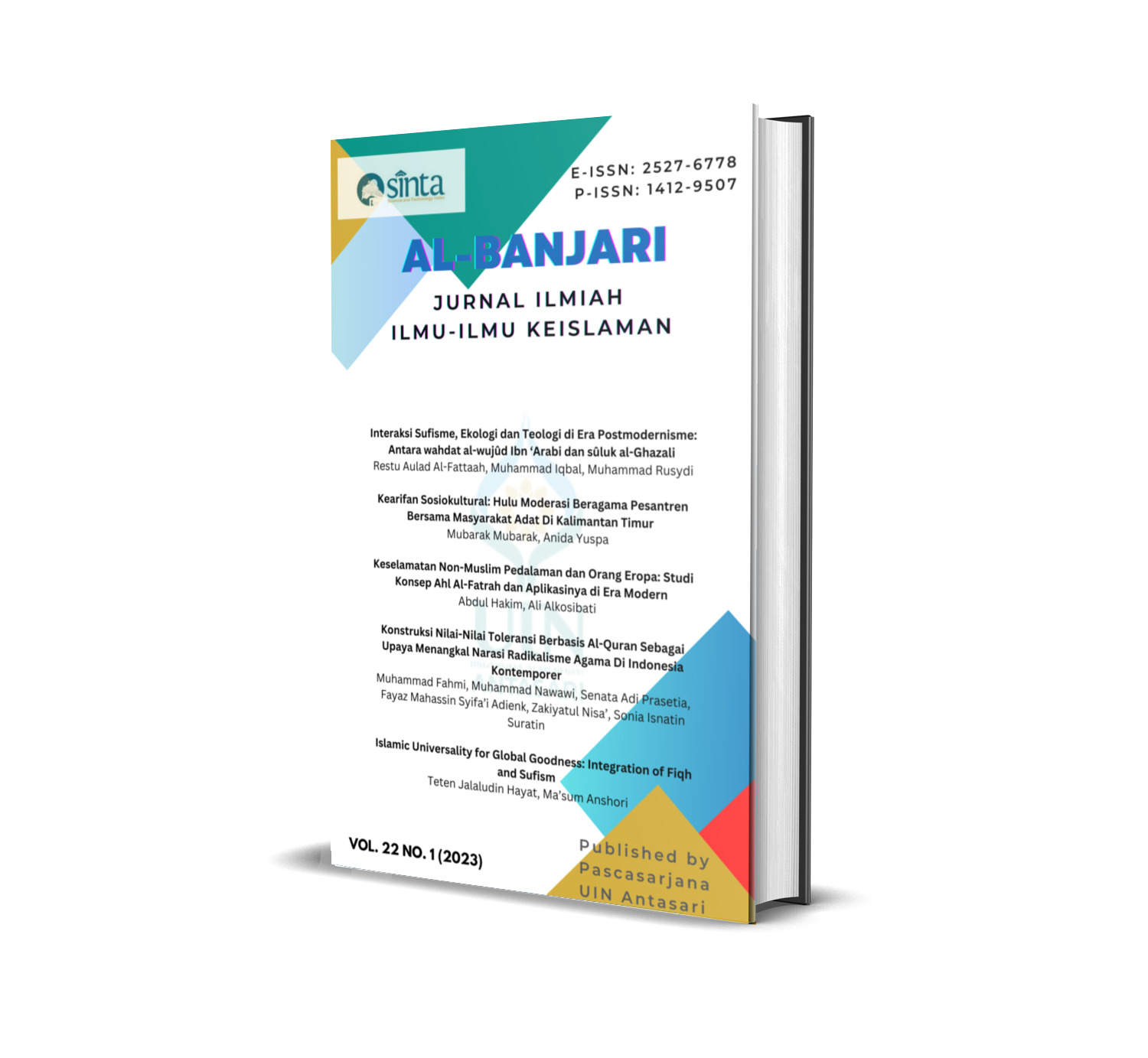Serba-Serbi Tarekat Era Modern (Corak Ajaran dan Perilaku Keseharian Pengamal Tarekat di Kalimantan Tengah dan Kalimantan Selatan)
DOI:
https://doi.org/10.18592/albanjari.v22i1.8505Keywords:
Tarekat, Corak Ajaran, Perilaku Pengamal Tarekat.Abstract
Tarekat as part of the Islamic sharia sufism occupies an important position for the civilization of the Muslims from the past to the present because it has influenced various aspects of life ranging from worship, social, educational to political ordinances. Doctrinal patterns tarekat also varies depending on the respective guru/sheikh/mursyid, however, it can be classified in general into three types, namely: a. tarekat Falsafi, b. tarekat Akhlaqi, dan c. tarekat Amali.This research uses library research methods with a descriptive approach and the analysis is socio-holistic. As for the focus of research, it is to lead and intend to describe the pattern of teachings tarekat and the daily behavior of the practitioner tarekat at Kalimantan Tengah dan Kalimantan Selatan. The results of the study found the pattern of teachings tarekat which grows and develops in wilayah Kalimantan Tengah dan Kalimantan Selatan Tend towards the breed tarekat akhlaqi dan amali as well as towards tarekat falsafi. As for the daily behavior of the practitioner tarekat viewable and categorized mulai tata speaking, dressing, and worship practices some show that he is a practitioner tarekat, there is also a choice to hide it. Then there are also practitioners tarekat which is consistent with one teaching tarekat which he followed in the first place, there are also those who practice more than one teaching tarekat and there are also laymen (general) who practice the teachings tarekat because watching recitation events in cyberspace (social media) such as YouTube, Facebook, Instagram, Tiktok, and recordings video yet never followed at all tarekat.References
A’dam, Syahrul. (2016). “Implikasi Hubungan Kyai dan Tarekat pada Pendidikan Pesantren”. Kordinat. Vol. 15 No. 1.
Alamsyah dkk. (2021). “Pemikiran Tasawuf KH. Mochjar Dahri dalam Kitab Mursyid Al-‘Ibȃd Ilȃ Sabȋl Ar-Rasyȃd dan Ȃtsȃr At-tashawwuf Fȋ Hayȃt Al-Muslim”. Ilmu Ushuluddin. Vol. 20 No. 2.
As’ad, Mahrus. (2012). “Pengaruh Neosufisme Terhadap Perkembangan Tasawuf dan Tarekat Baru”. MIQOT. Vol. 36 No. 1.
Bisri Mustofa, M. (2019). “Munculnya Tarekat Baru Abad Pertengahan Hingga Kini”. Az-Ziqri, 2019. Vol. 1 No. 02.
Idham Kholid, A. R. (2018). “Menuju Tuhan Melalui Tarekat (Kajian Tentang Pemikiran Tasawuf)”. YAQZHAN. Vol. 4 No. 1.
Iqbal Ramadhan, Moh. (2022). “Pemaknaan Konsep Agama Perspektif Tarekat (Studi Kasus Tarekat Sunan Anbia)”. Al-Mutharahah. Vol. 19 No. 1.
Khamim, M. (2021). “Sufisme dan Perubahan Sosial: Kaum Tarekat dan Dinamika Sosial Keagamaan”. Al-Isnad. Vol. 2 No. 1.
Khoirul Fata, Ahmad. (2022). “Tarekat”. Al-Ulum. Vol. 11 No. 2.
Kulsum, Ummu. (2020). “Pendidikan Tasawuf Ekspetasi Imam Al-Ghazali pada Masa Nizam Al-Mulk”. Ahsan Media. Vol. 6 No. 2.
Mujab, Saiful. (2017). “Memahami Tradisi Spiritualitas Pesantren (Sebuah Analisis Sosio-Historis Terhadap Spiritualitas Pesantren di Indonesia)”. Asketik. Vol. 1 No. 2.
Rahmadi. (2020). “Membincang Proses Islamisasi di Kawasan Kalimantan dari Berbagai Teori”. Khazanah. Vol. 18 No. 2.
Ridlo, Miftakhur. (2020). “Sejarah dan Tipologi Tarekat dalam Pandangan Tasawuf dan Makrifat”. Humanistika. Vol. 3 No. 1.
Rosyid, Moh. (2018). “Potret Organisasi Tarekat Indonesia dan Dinamikanya”. Religia. Vol. 21 No. 1.
Hermanto dan Suryanti. (2021). “Sejarah Masjid Al-Iman di Desa Telaga, Kecamatan Kamipang, Kabupaten Katingan, Provinsi Kalimantan Tengah, 1939-2020”. Syams. Vol. 2 No. 2.
Zakki Mubarak, Ahmad. (2011). “Penyebaran Tarekat Sammaniyah di Kalimantan Selatan Oleh K.H. Muhammad Zaini Ghani”. AL-BANJARI. Vol. 10 No. 1.
Haisusyi dkk. (2018). Bunga Rampai Sejarah Pemikiran dan Peradaban Islam, ed. Hamdanah dan Zainap Hartati. Yogyakarta: K-Media.
Zakarias El Bilad, Cecep. (2021). Mengenal Tarekat Qadiriyah Naqsabandiyah Bekal Wawasan Bagi Ikhwan TQN Suryalaya. Jawa Barat: CV. Latifah Press, Cet, 3.
Downloads
Published
Issue
Section
License
Copyright (c) 2023 Al-Banjari : Jurnal Ilmiah Ilmu-Ilmu Keislaman

This work is licensed under a Creative Commons Attribution-ShareAlike 4.0 International License.
Authors who publish with this journal agree to the following terms:
- Authors retain copyright and grant the journal right of first publication with the work simultaneously licensed under a Creative Commons Attribution License that allows others to share the work with an acknowledgement of the work's authorship and initial publication in this journal.
- Authors are able to enter into separate, additional contractual arrangements for the non-exclusive distribution of the journal's published version of the work (e.g., post it to an institutional repository or publish it in a book), with an acknowledgement of its initial publication in this journal.
- Authors are permitted and encouraged to post their work online (e.g., in institutional repositories or on their website) prior to and during the submission process, as it can lead to productive exchanges, as well as earlier and greater citation of published work (See The Effect of Open Access).


































